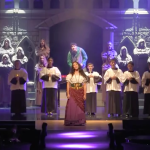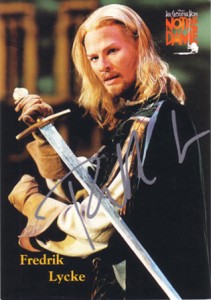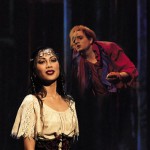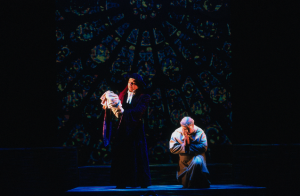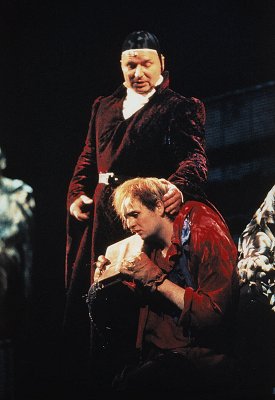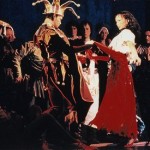The King’s Academy version of the Hunchback exist as step between Der Glockner von Notre Dame and the official American musical version of La Jolla and Papermills. The King’s version has some core differences of Glockner and even the Disney movie. Also Please note, I’m working off of memory, I had hope to re-watch it and make a list but I couldn’t do that so I probably will miss things.
So the big difference and something that I find a unforgivable is Phoebus or rather not Phoebus. This version calls him Edgrick, I’m not sure why they changed his name. The did change the gargoyle names back to there original Disney name of Victor, Hugo and Laverne instead of the Glockner names Charles, Loni and Antoine. Also in this production Phoebus does not sing. This Phoebus’ signature song of Ein bißchen Freude or Rest and Recreation does not occur. Also Out of Love is cut which is also cut from the La Jolla version. He also doesn’t sing in Esmeralda instead Frollo sings Phoebus’s part which doesn’t make that much sense as the Frollo asks why he hears her words inside his head I have no idea what he would be referring to, though the lyrics have been changed somewhat.
King’s version
Frollo:
Why do I long for Esmeralda?
Why do I hear her words inside my head?
Why do I think of Esmeralda?
With all the Gypsies Beggars left for Dead
Yes my Duty calls for
Paris is Burning
Lit to expose that furtive pair
Sneaking about
Out There
Glockner
Phoebus:
What have I done for Esmeralda?
Why do I hear her voice inside my head?
Why do I think of Esmeralda?
With my career and prospects left for dead?
Frollo:
Once more my Duty calls
Paris is Burning
Lit to expose that furtive pair
Sneaking about
Out There
http://www.shipperland.de/miracles/
I wish Phoebus or Edgrick had sung in Esmeralda be it harkens to the basis of the book three guys and how they hearts are made different with regard to one woman. Plus it adds rich to the big act ending song.
Another cut song from the Glockner version is Tanz auf dem Seil or Dance on the Rope which served as Esmeralda’s introduction. Instead she appears dancing before a crowd like in the movie. The La Jolla version also cut Dance of the Rope and opted for keeping the dance angle but added the song Rhythm of the Tambourine.
The King’s Academy also cut Tanz der Zigeuner, Dance of the Gypsies and reintroduced The Court of Miracle from the original. Minor change really.
Clopin doesn’t narrate the tale as a beggar which he does in Glockner. In the King’s versions he is in his jester costume at the start. Minor change.
However the big change is at the end, no one dies and I mean no one, well except Quasimodo’s mother. But Frollo lies, he is about to attack Quasimodo and Esmeralda but he just walks off. This could be because he said care for the child.
A curious addition and not really a change but it needs to be mention is Djali isn’t in this version but one of Hugo’s lines mention Djali not by name but he does say “the one in the dress ain’t bad either” referencing to the nonexistent Djali.
Again I’m probably missing other difference between the shows but those are the one I remember and can find
Next Time -Direction and Staging


